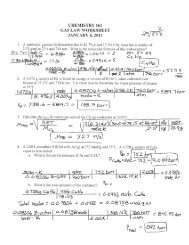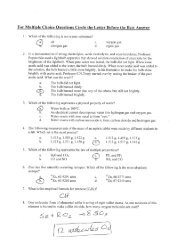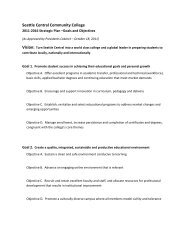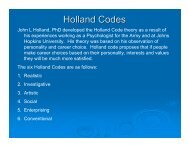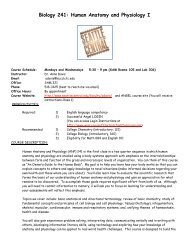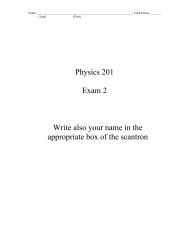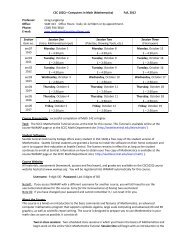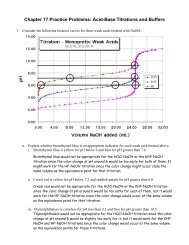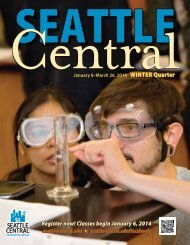Math 238 - Seattle Central Community College
Math 238 - Seattle Central Community College
Math 238 - Seattle Central Community College
- No tags were found...
Create successful ePaper yourself
Turn your PDF publications into a flip-book with our unique Google optimized e-Paper software.
<strong>Seattle</strong> <strong>Central</strong> <strong>Community</strong> <strong>College</strong><strong>Math</strong> <strong>238</strong> – Differential EquationsCourse Syllabus Fall 2012Instructor InformationName: Greg Langkamp Phone: 206 - 934 - 3810Email: greg.langkamp@seattlecolleges.eduOffice: SAM 413 Office Hours: Mon-Fri 12-12:50 pm, or by appointment.Prerequisites: MATH&152 w/ 2.0 or higher w/in the last 3 years. MATH&153 highly recommended w/in the last 3years. If you have not taken <strong>Math</strong> 153, you will have much extra work to do!!<strong>Math</strong>ematica Proficiency Required: Students taking this course must be proficient with the <strong>Math</strong>ematica softwareprogram. Students who do not have experience with <strong>Math</strong>ematica should register for CSC102Q. This 1-creditcourse begins the 2 nd week of the quarter and ends the 4 th week of the quarter. Many sections of CSC102Q arebeing offered – please consult the SCCC website for section days, times, and openings.1 st day Attendance: Students must attend the first day of class or they will be dropped from the course. If youcannot attend the 1 st day, you must contact me by the start of the first class.Waitlist Policy: At the end of the 1 st class I will know how many students can be added to the class. Those studentson the electronic waitlist who attend the first day will be added to the class in order according to their waitlistrank. There is no guarantee that anyone will be added into the course. Students on the waitlist should be preparedto show proof of their prerequisites before I sign their red registration “add” form.Course format: I believe the best way for students to learn is to do the math, rather than listen to a teacher tellthem how to do the math. To this end, I try to minimize lecture time in class to incorporate active studentexercises (often in groups). Since we sometimes start group activities immediately, it is unacceptable to arrive lateto class. I understand that occasionally things come up - but frequent, late arrivals may impact your grade.There will be several “reading assignments” to encourage you to read the text and other materials independent ofmy lectures and presentations. These will be collected and graded regularly. No late work accepted.Classroom: This course meets daily in a computer classroom. No food or drink is allowed in the classroom. Plasticbottles with tight lids can be kept in your book bag under the desks. Please keep the classroom clean. Like in thewilderness, clean it up even if you did not make the mess!Course Materials:a) Textbook: Blanchard, Devaney and Hall, Differential Equations, 4 th ed. Cengage pub., 2012.ISBN: 978-O-495-56198-9b) Pencil, eraser, graph paper, and small ruler. All handwritten work must be submitted in pencil!!c) USB Flash drive (a.k.a. thumb drive) to store computer files.d) A graphing calculator may be useful. Cannot have algebraic capabilities (nothing above a TI-85/86). Rentalsavailable for $10 – see me if interested.e) OPTIONAL: Student Solution Manual. ISBN: 978-0-495-82672-9Internet Access: This course requires that you access the internet several times each week. Students who do nothave internet access at home will need to use computers in the SCCC computer labs, in a local library, etc. If youwish to print at SCCC, you may need a print card or student ID with credit on it.1
Course Technology:A) WAMAP: This course will make use of WAMAP, an online course-management program. There are threefeatures of wamap that we will make use of: (1) in WAMAP I will post class announcements, grades, anddocuments to read or download. (2) WAMAP has an internal message system, which allows you and me tocontact members of the class. (3) an online homework system.You will be registered into WAMAP and added to my class automatically. To sign in:Go to www.wamap.org. Username: 9 digit SID Password: Last 4 digits of SIDNote#1: If you access WAMAP with a different username for another course, you will still need touse the username listed above for this course. Sorry for the inconvenience of having two usernames!Note #2: If you have changed your password and cannot remember it, I can reset it for you.B) DETools Textbook software: We will frequently use the DETools Java applet that comes with the text. Each newtextbook comes with an access code to download a copy of the applet. If you have a used text and want to buy anaccess code ($45), go to http://www.cengagebrain.com/shop/isbn/9780495562009. We also have DETools on theSCCC student network.C) <strong>Math</strong>ematica software: We will occasionally use the <strong>Math</strong>ematica software program, which is also on thestudent network. SCCC Students can download a free copy of <strong>Math</strong>ematica for Students at the <strong>Math</strong> DepartmentWebsite: http://www.seattlecentral.edu/learn/math/mathematica.html.Workload for this course: You should expect to spend on average 2 hours per day for this course outside of class;this time will consist of reading your textbook, reading your class notes, doing homework problems from thetextbook, studying for quizzes and exams, and preparing for special class days. Watch the WAMAP calendar closelyfor due dates.Course Contents: Below is an tentative week-by-week guide to the course, with text sections numbers.Week Topics and sections in BDH1 Modeling, Separation of Variables, Slope Fields (1.1, 1.2, 1.3)2 Euler’s Method, Existence/Uniqueness Thm., Phase Lines (1.4, 1.5, 1.6)3 Bifurcations, Linear Equations, Integrating Factors (1.7, 1.8, 1.9)4 Integrating factors, Series solutions, (1.9, App. B) exam #15 System Modeling, Damped Harmonic Oscillators (2.1, 2.2, 2.3)6 Euler’s and EU Thm, Linear Systems and Real Eigenvalues (2.4, 2.5, 2.6, 3.1, 3.2)7 Phase portraits, Complex, repeated and zero eigenvalues (3.3, 3.4, 3.5, 3.6)8 2 nd order linear equations, more power series, exam #29-10 Forced Harmonic Oscillators and resonance (4.1, 4.2, 4.3); Exact and Bernoulli Eq. (notes)11 Laplace Transforms – if time allows (6.1, 6.2, 6.3)12 Final ExamTextbook homework: For each section in the textbook I will assign a set of homework problems. Odd-numberedproblems have answers in the back of the text and worked-out solutions in the Student Solutions Manual. I willcollect some of this homework – see WAMAP for details. No late homework accepted, except with a late pass.WAMAP homework: Several sections in the text have corresponding WAMAP online problems. Watch theWAMAP calendar for details. In the second week I will give everyone 1 “late pass” for these problems.2



